Back in December 1999, these were the questions on the minds of fans…
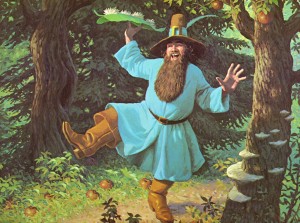 Q: Gandalf and the other wizards were obviously powerful Maiar sent to protect Middle Earth. If Tom Bombadil is a lesser Maiar, then why was Tom completely unaffected by the ring when he placed it on his finger, Tom didn’t even disappear. When Gandalf was offered the ring he refused saying that the power would corrupt him as any other. I hope you can explain this to me. I don’t think it’s because Tom Bombadil didn’t want power so he was unaffected, because Gandalf was just as uninterested in power as Tom. Thank you.
Q: Gandalf and the other wizards were obviously powerful Maiar sent to protect Middle Earth. If Tom Bombadil is a lesser Maiar, then why was Tom completely unaffected by the ring when he placed it on his finger, Tom didn’t even disappear. When Gandalf was offered the ring he refused saying that the power would corrupt him as any other. I hope you can explain this to me. I don’t think it’s because Tom Bombadil didn’t want power so he was unaffected, because Gandalf was just as uninterested in power as Tom. Thank you.
– The Dunedain
A: It seems more plausible that Tom Bombadil was uninterested in the kind of power that the Ring conveyed. Tom also clearly had his own boundaries, at least geographically, for when he takes leave of the hobbits he says “Tom’s country ends here: he will not pass the borders”. If Tom would have been persuaded to take the Ring, it would, over time and in the end, have worked its power upon him and corrupted him. But for the short time of its passage through his own country, it seems not to have affected him, and within the boundaries of his own realm, Tom seems certainly to have been Master.
– Turgon
Update!
A few people have written in questioning whether Tom Bombadil might not actually be Eru. Truly, there are no hints of this in Tolkien’s writings, and I think that such a Twilight-Zone styled twist would be uncharacteristic of him. Also, in view of Tolkien’s devotion to his Catholicism, and in light of his extensive rationalization of “sub-creation” in his famous essay “On Fairy-Stories”, I just don’t think his mind worked that way. But that’s only my view.
– Turgon
Update to Update!
One reader wrote in to point out a few passages in Letters where Tolkien states explicitly that, in Middle-earth, “there is no embodiment of the One, of God, who indeed remains remote, outside of the World, and only directly accessible to the Valar or Rulers”. These statements rule out the possibility that Tom Bombadil might be Eru.
Another theory that has been proposed is that Tom Bombadil is Aule. For more on this, see the essay by Gene Hargrove at: http://www.cas.unt.edu/~hargrove/bombadil.html
(Personally, I don’t find this argument convincing, but the possibility is intriguing.)
– Turgon
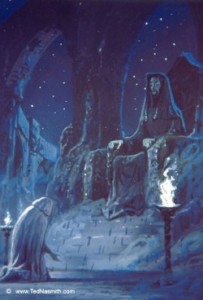
Q: In “Unfinished Tales,” reference is made to “The Second Prophecy of Mandos.” This foretells the Dagor Dagorath, the final battle against Melkor that will end the world (a la Ragnarok, Armageddon). But except for that tidbit, the Second Prophecy is a throwaway reference. So I’m asking–when did Mandos make this prophecy? Where and under what circumstances? What mortal ears heard it? And what, exactly, does it prophecy? Is there more to it? The First Prophecy (which I’m assuming refers to the Doom cast on the Noldor as they were high-tailin’ it out of Aman) was pretty specific and wide-ranging. The Second must be more substantial than simply, “There’s gonna be a big fight with Morgoth”.
-The Prankster
A: The reference in Unfinished Tales comes from a passage quoted in the section on “The Istari”, and reads as follows: “Manwe will not descend from the Mountain until the Dagor Dagorath, and the Coming of the End, when Melkor returns” (p. 395). Christopher Tolkien has footnoted this to read: “This is a reference to ‘the Second Prophecy of Mandos’, which does not appear in The Silmarillion; its elucidation cannot be attempted here, since it would require some account of the history of the mythology in relation to the published version.” (footnote 8, p. 402).
Unfinished Tales came out in 1980, and fortunately, with the publication in 1986 of volume four of The History of Middle-earth, entitled The Shaping of Middle-earth, we can understand much more about the Second Prophecy of Mandos. It appears in this volume in two forms, in the earliest ‘Silmarillion’, the ‘Sketch of the Mythology’ as written for Tolkien’s former teacher R. W. Reynolds around 1926, and in the ‘Quenta Silmarillion’ proper, written around 1930. For the version from the earliest ‘Silmarillion’, see section 19, pp. 40-1 of The Shaping of Middle-earth. The second version, from which I give some extracts below, can be found in full in section 19 , pp. 163-5 of the same volume:
“After the triumph of the Gods, Earendel sailed still in the seas of heaven, but the Sun scorched him and the Moon hunted him in the sky . . . Then the Valar drew his white ship Wingelot over the land of Valinor, and they filled it with radiance and hallowed it, and launched it through the Door of Night. And long Earendel set sail into the starless vast, Elwing at his side, the Silmaril upon his brow, voyaging the Dark behind the world, a glimmering and fugitive star. And ever and anon he returns and shines behind the courses of the Sun and Moon above the ramparts of the Gods, brighter than all other stars, the mariner of the sky, keeping watch against Morgoth upon the confines of the world. Thus shall he sail until he sees the Last Battle fought upon the plains of Valinor.
“Thus spake the prophecy of Mandos, which he declared in Valmar at the judgement of the Gods, and the rumour of it was whispered among all the Elves of the West: when the world is old and the Powers grow weary, then Morgoth shall come back through the Door out of the Timeless Night; and he shall destroy the Sun and the Moon, but Earendel shall come upon him as a white flame and drive him from the airs. Then shall the last battle be gathered on the fields of Valinor. In that day Tulkas shall strive with Melko, and on his right shall stand Fionwe and on his left Turin Turambar, son of Hurin, Conqueror of Fate; and it shall be the black sword of Turin that deals unto Melko his death and final end; and so shall the Children of Hurin and all men be avenged.
“Thereafter shall the Silmarils be recovered out of sea and earth and air; for Earendil shall descend and yield up that flame that he hath had in keeping. Then Feanor shall bear the Three and yield their fire to rekindle the Two Trees, and a great light shall come forth; and the Mountains of Valinor shall be levelled, so that the light goes out over all the world. In that light the Gods will again grow young, and the Elves awake and all their dead arise, and the purpose of Iluvatar be fulfilled concerning them. But of Men in that day the prophecy speaks not, save of Turin only, and him it names among the Gods.”
– Turgon
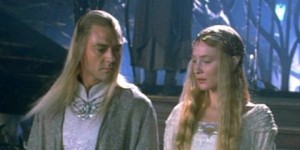 Q: Back a while ago (before the internet) I remember seeing a piece written where someone was arguing that Tolkien elves were actually taller than humans. I don’t remember where it was but that doesn’t matter now. Is there any actual mention in any of the books or professor Tolkien’s letters about this? Or are elves really shorter as is shown in just about every picture painted of the Fellowship (i.e. Legolas and the humans)? If they are shorter, how do the half-elves (Elrond and Aragorn’s line) all end up being generally bigger than other humans?
Q: Back a while ago (before the internet) I remember seeing a piece written where someone was arguing that Tolkien elves were actually taller than humans. I don’t remember where it was but that doesn’t matter now. Is there any actual mention in any of the books or professor Tolkien’s letters about this? Or are elves really shorter as is shown in just about every picture painted of the Fellowship (i.e. Legolas and the humans)? If they are shorter, how do the half-elves (Elrond and Aragorn’s line) all end up being generally bigger than other humans?
-Mark Ervin
A: The cheating answer is to use Robert Foster’s Complete Guide to Middle-earth and cite his entry for Elves, in which he writes, “Elves were the fairest of all earthly creatures, and resembled the Ainur in spirit. They were about six feet tall and somewhat slender…”. But the real challenge is to find where in Tolkien that Foster found this information. In The Lord of the Rings, the first meeting with an Elf occurs in Book I , Chapter 3, “Three Is Company”, where the hobbits encounter Gildor and his party of elves in the Shire. As the hobbits are marching along with them, Pippin begins to stagger, “but each time a tall Elf at his side put out his arm and saved him from a fall”. Later in The Fellowship of the Ring, in Book II, Chapter 7, “The Mirror of Galadriel”, when the fellowship meets Celeborn and Galadriel, they are described as follows: “Very tall they were, and the Lady no less tall than the Lord”. I’m sure that there are other similar references scattered throughout the books. The earliest mention chronologically within Tolkien’s life that I can find about the stature of Elves comes from Tolkien’s early poetry, c. 1915, in which the Elves were conceived with a diminutive stature. But, as Christopher Tolkien notes in The Book of Lost Tales, Part One, “All the ‘elfin’ diminutiveness soon disappeared” (p. 32). And in the prose narrative of The Book of Lost Tales (written c. 1917-20) there is some confusion as to whether Men or Elves were of a greater stature, but they are certainly seen to be of a similar size. One added note by Tolkien states that “Men were almost of a stature at first with Elves, the fairies being far greater and Men smaller than now.” (p. 235) Tolkien seems to have regarded Men and Elves to be of a similar size for the rest of his life.
– Turgon
Update!
Vladimir Lukic sent in a bunch of interesting observations, pointing out that there are some really fascinating comments in Tolkien’s notes on “Numenorean Linear Measures,” published inUnfinished Tales (pp. 285-287). Tolkien writes of the unit of measurement “ranga” that “two rangar was often called ‘man-high’, which at thirty-eight inches gives an average height of six feet four inches; but this was at a later date, when the stature of the Dunedain appears to have decreased. . . . Elendil was said to be ‘more than man-high by nearly half a ranga’; but he was accounted the tallest of all the Numenoreans who escaped the Downfall. The Eldar of the Elder Days were also very tall. Galadriel, ‘the tallest of all the women of the Eldar of whom tales tell’, was said to be man-high, but it is noted ‘according to the measure of the Dunedain and the men of old’, indicating a height of about six feet four inches.”
– Turgon
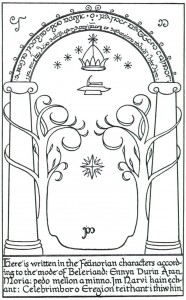 Q: At the Doors of Durin, what is Gandalf referring to when he says that Merry of all people was on the right track about the proper words to open the gates? I can’t see that Merry says anything very profound.
Q: At the Doors of Durin, what is Gandalf referring to when he says that Merry of all people was on the right track about the proper words to open the gates? I can’t see that Merry says anything very profound.
-Dr.Joe
A: Gandalf read the elf-letters on the Doors of Durin as follows:
“The words are in the elven-tongue of the West of Middle-earth in the Elder Days,” answered Gandalf. ‘But they do not say anything of importance to us. They say only: The Doors of Durin, Lord of Moria. Speak, friend, and enter. And underneath small and faint is written: I, Narvi, made them. Celebrimbor of Hollin drew these signs.”
“What does it mean by speak, friend, and enter?” asked Merry.
“That is plain enough,” said Gimli. “If you are a friend, speak the password, and the doors will open, and you can enter.” (The Fellowship of the Ring, p.318)
Merry’s observation was not very profound, but he was at least questioning the odd phrasing of “speak, friend, and enter”, and its meaning. The phrasing proved to be the key to opening the door, as Gandalf soon figured out. The translation should have been “Say ‘friend’ and enter”, and Gandalf merely had to say the Elvish word for ‘friend’, mellon, and the doors opened.
– Turgon
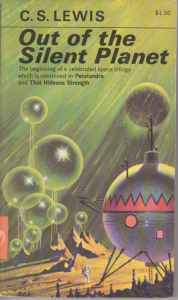 Q: What do you know of the theory that the hero in C.S. Lewis’ space trilogy is actually a thinly discussed characterization of Prof. Tolkien?
Q: What do you know of the theory that the hero in C.S. Lewis’ space trilogy is actually a thinly discussed characterization of Prof. Tolkien?
A: Tolkien himself felt that Ransom (at least in the first two books of the so-called Space Trilogy, Out of the Silent Planet and Perelandra) resembled himself in superficial ways. In a letter to Stanley Unwin of 18 February 1938, Tolkien wrote about the Ransom in Out of the Silent Planet as being the hero who “is a philologist (one point in which he resembles me) ” (Letters, no. 24). But in a letter to Christopher Tolkien of 31 July 1944, Tolkien mentions that his daughter Priscilla has “just read Out of the Silent Planet and Perelandra; and with good taste preferred the latter. But she finds it hard to realise that Ransom is not meant to be a portrait of me (though as a philologist I may have some part in him, and recognize some of my opinions and ideas Lewisified in him)” (Letters, no. 77).
So it seems at least some elements of Tolkien ended up in the character Ransom, but I doubt that Lewis himself intended the character to be in any sense a ‘real’ portrait of his friend. The relevance of real people to fictional characters is always a difficult issue, as the characters tend to grow to meet the needs of the story, taking on a life of their own, and then they become something other than that which they might have started out being. As anyone who has ever read the third volume of the trilogy will tell you, That Hideous Strength is rather a different book than the first two. It certainly grew and evolved in ways to match the changes in Lewis’ own life during the time of its writing, and it shows the considerable influence of Charles Williams, whom Lewis did not know particularly well when he wrote the first volume. So things evolve, and things change.
– Turgon
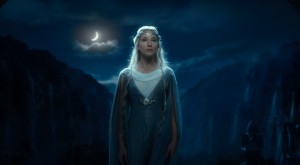 Q: So how is Glorfindel an Elf-Lord? The Glorfindel that crossed over with the Noldor in Silmarillion fell in battle with a Balrog while escaping Gondolin. And the Noldor are the only elves who crossed over, weren’t they? The only thing I can think of is the possibility that Glorfindel was a descendant of Thingol, who of course made the initial trip to Valimar and then didn’t make it back the second time around. Also, since Thingol married well (to say the least), all of his descendants could be considered Elf-Lords, I guess. But is there anything in writing that supports the idea of Glorfindel being a descendant of Thingol?
Q: So how is Glorfindel an Elf-Lord? The Glorfindel that crossed over with the Noldor in Silmarillion fell in battle with a Balrog while escaping Gondolin. And the Noldor are the only elves who crossed over, weren’t they? The only thing I can think of is the possibility that Glorfindel was a descendant of Thingol, who of course made the initial trip to Valimar and then didn’t make it back the second time around. Also, since Thingol married well (to say the least), all of his descendants could be considered Elf-Lords, I guess. But is there anything in writing that supports the idea of Glorfindel being a descendant of Thingol?
-Tom Phillips
A: This questions ties into the whole problem of whether the Glorfindel of The Silmarillion, who was killed in a fight with a Balrog in Gondolin, is the same Glorfindel as is found in The Lord of the Rings. Tolkien himself considered this, and wrote a few fascinating short essays, which are printed in The Peoples of Middle-earth, pp. 377-82. I recommend that anyone interested in this very curious matter seek them out.
In one of these pieces Tolkien himself interprets a small passage in The Fellowship of the Ring (from p. 235) as pertaining to Glorfindel (when the passage itself doesn’t necessarily have to refer to him). Tolkien writes that Glorfindel “is said to have been one of the ‘lords of the Eldar from beyond the furthest seas … who have dwelt in the Blessed Realm.’.” [p. 379 of The Peoples of Middle-earth; the ellipses are Tolkien’s] This would rule out Glorfindel being Sindarin (and thereby ruling out the possibility that he is a descendant of Thingol).
Though it remains problematical, one nearly has to come to the conclusion that the Glorfindel of The Silmarillion, slain in the Fall of Gondolin, was indeed reborn in Aman and allowed to return to Middle-earth, where he had a role to play in the War of the Ring, as is narrated in The Lord of the Rings.
– Turgon
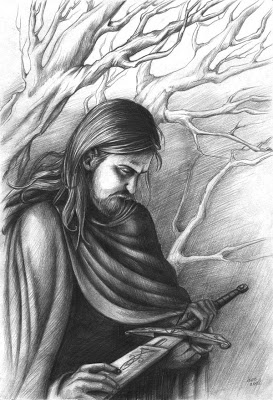
Q: More out of curiosity then an attempt to stump…..how is it that the sword of Turin, Gurtholfin, was able to speak? What other details of this artifact can you guys did up?
A: Turin’s sword was named Gurtholfin, ‘Wand of Death’, in The Book of Lost Tales. In later writings, particularly in the published Silmarillion and in the “Narn i Hin Hurin” in Unfinished Tales, it was called Gurthang, or ‘Iron of Death’. It was named thus after it was reforged in Nargothrond from Anglachel, the sword of Beleg. The Silmarillion describes it being “though ever black its edges shone with pale fire”. And Turin’s use of it on the Guarded Plain made him known as Mormegil, the Black Sword.
To turn back to The Book of Lost Tales, it is described therein as follows: “It was made by magic to be utterly black save at its edges, and those were shining bright and sharp as but Gnome-steel may be. Heavy it was, and was sheathed in black, and it hung from a sable belt, and Turin named it Gurtholfin the Wand of Death; and often that blade leapt in his hand of its own lust, and it is said that at times it spake dark words to him” (The Book of Lost Tales, Part Two, p. 83).
The important passage where the sword itself speaks is found first in The Book of Lost Tales, and later in revised forms in the “Narn i Hin Hurin” and in The Silmarillion. I quote from the latter:
“There he [Turin] drew forth his sword, that now alone remained to him of all his possessions, and he said: ‘Hail Gurthang! No lord or loyalty dost thou know, save the hand that wieldeth thee. From no blood wilt thou shrink. Wilt thou therefore take Turin Turambar, wilt thou slay me swiftly?’
“And from the blade rang a cold voice in answer: ‘Yea, I will drink thy blood gladly, that so I may forget the blood of Beleg my master, and the blood of Brandir slain unjustly. I will slay thee swiftly.'” (p. 225)
Within the world of Middle-earth it is indeed odd for a sword to speak. There are some instances of animals speaking (I am thinking here of Huan in The Silmarillion, of the eagles and spiders and ravens in The Hobbit, and then there is that curious fox in The Lord of the Rings who passes the hobbits sleeping out in the Shire, in Book 1 Chapter 3, and “thinks” for a few sentences…), but the speaking inanimate object seems very unusual. I don’t really have a good answer for this within the world of Middle-earth itself, unless, for some reason the Valar permitted the sword to speak (or spoke through it), but that seems to be interpreting too far.
There is a more reasonable answer to this question, which comes from Tolkien’s own sources. As an undergraduate, Tolkien had become enamoured with the Finnish epic Kalevala, in the W. F. Kirby translation. The Kalevala includes the story of the hapless Kullervo, whose basic story resembles Turin’s very closely. (In fact, Tolkien himself wrote a verse-version of “The Story of Kullervo” in 1914, but this has never been published.) In both stories, Kullervo and Turin, after similar upbringings, fall in love unknowingly with their own sisters, and when the sisters learn of their incest, they drown themselves. Kullervo, like Turin, seeks release from his life from his sword, asking it if it will drink his blood. Kullervo’s sword answers very similarly, and takes its master’s life in an identical manner. The following quotation comes from the W. F. Kirby translation of the Kalevala:
Kullervo, Kalervo’s offspring
Grasped the sharpened sword he carried,
Looked upon the sword and turned it,
And he questioned it and asked it,
And he asked the sword’s opinion,
If it was disposed to slay him,
To devour his guilty body,
And his evil blood to swallow.
Understood the sword his meaning,
Understood the hero’s question,
And it answered him as follows:
“Wherefore at thy heart’s desire
Should I not thy flesh devour,
And drink up thy blood so evil?
I who guiltless flesh have eaten,
Drank the blood of those who sinned not?”
Kullervo, Kalervo’s offspring,
With the very bluest stockings,
On the ground the haft set firmly,
On the heath the hilt pressed tightly,
Turned the point against his bosom,
And upon the point he threw him,
Thus he found the death he sought for,
Cast himself into destruction.
– Turgon
Update!
A reader who signed himself “The Blacksword” provided some additional, very interesting insights into the question of Turin’s speaking sword:
“The answer comes from within Middle Earth. In The Silmarillion, there is a passage in [Chapter 21] ‘Of Turin Turambar’ which may provide some insight as to how the Gurthang spoke. It is as follows, ‘Then Beleg chose Anglachel; and that was a sword of great worth and it was so named because it was made of iron that fell from heaven as a blazing star. . . . and that smith was Eol the dark elf. . . . He gave Anglachel to Thingol as a fee, which he begrudged, for leave to dwell in Nan Emloth.’ [p. 201-2] And later, ‘But as Thingol turned the hilt of Anglachel towards Beleg, Melian looked at the blade; and she said: “There is malice in this sword. The dark heart of the smith still dwells in it. It will not love the hand it serves.”‘ [p. 202]
“Gurthang is Anglachel after it was reforged. At this time we know that Eol is slain, in the Nirnaeth Arnoediad Maeglin fought beside Turgon, and Eol his father was cast from Caragdur only a few days after Maeglin arrived in Gondolin. Turin was a boy when Hurin went off to that battle. There are instances in Middle Earth where spirits inhabit places; the Barrow-wights, the Dead men of Dunharrow, the Dead Marshes, Caradhras, I am sure there are more examples. I can’t think of any examples of elven spirits inhabiting objects, however, one could argue that the spirit of Sauron inhabited The Ring. . . . The conclusion is that the spirit of Eol was within the sword, and that was how it spoke. Perhaps the strange origin of the iron also made it possible for the sword to be ‘possessed.'”
Thanks for writing in and sharing these insights.
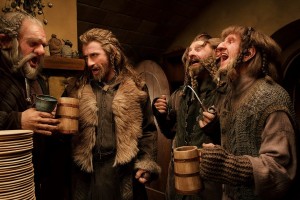 Q: Did the Decline of the Elves (in the Fourth Age) also affected the Dwarves? Did they ever went back to live in Moria? What’s the story around that place where Durin used to go, at Moria’s top, that Gimli tells us about?
Q: Did the Decline of the Elves (in the Fourth Age) also affected the Dwarves? Did they ever went back to live in Moria? What’s the story around that place where Durin used to go, at Moria’s top, that Gimli tells us about?
thanks from Buenos Aires
–Juan Pablo Pasini
A: In The Peoples of Middle-earth, Christopher Tolkien quotes a short passage from an earlier version of the Tale of Years (Appendix B in The Lord of the Rings) in which his father wrote: “The Fourth Age ushered in the Dominion of Men and the decline of all the other ‘speaking-folk’ of the Westlands” (p. 172). In another passage from the same volume Christopher quotes from a version of “Durin’s Folk” (a section of Appendix A in The Lord of the Rings) the following statement concerning the re-population of Moria in the Fourth Age: “And the line of Dain prospered, and the wealth and renown of the kingship was renewed, until there arose again for the last time an heir of that House that bore the name of Durin, and he returned to Moria; and there was light again in deep places, and the ringing of hammers and the harping of harps, until the world grew old and the Dwarves failed and the days of Durin’s race were ended.” (p. 278). Christopher Tolkien notes that while none of this is mentioned in The Lord of the Rings proper, “Durin VII and Last” is mentioned in the genealogical table accompanying the “Durin’s Folk” portion of Appendix A in The Lord of the Rings.
As to your third question, I think you mean Durin’s Tower, which was “carved in the living rock of Zirakzigil, the pinnacle of the Silvertine.” (The Two Towers, p. 105) This was at the very top of the Endless Stair, which ran from the lowest dungeon to the highest peak of Khazad-dum, and which Gimli said had long been lost, if it ever existed. Unfortunately, aside from this brief reference, I find no other significant mention of it.
– Turgon
Update!
A few readers have pointed out that Gandalf chased the Balrog up the Endless Stair, during their long struggle. And they came out at last through Durin’s Tower, “carved in the living rock of Zirakzigil, the pinnacle of the Silvertine.” (The Two Towers, page 105) In their struggle, Durin’s Tower was destroyed, and the stair ruined.
– Turgon
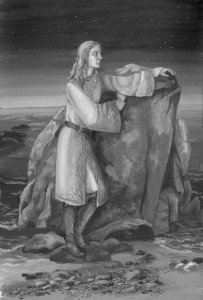
Q: I thought that there were only three marriages between men and elves: Luthien and Beren, Idril and Tuor and Aragorn and Arwen. But in “The Return of the King” at the beginning of chapter IX Legolas meets with prince Imrahil and he saw “that there indeed was one who had elven-blood in his veins”. So do other unknown marriages between the two races exist?
– Cathy
A: The reference you sight reads more fully: “At length they came to the Prince Imrahil, and Legolas looked at him and bowed low; for he saw that here indeed was one who had elven-blood in his veins. ‘Hail, lord!’ he said. ‘It is long since the people of Nimrodel left the woodlands of Lorien, and yet still one may see that not all sailed from Amroth’s haven west over water.” (p. 148, The Return of the King).
Amroth was a Silvan Elf (of the early Third Age), and thus not among the Eldar; Amroth founded the port of Dol Amroth in Belfalas, in the south of Gondor. Imrahil was, at the time of The Lord of the Rings, the Prince of Dol Amroth, and of Numenorean descent. The elvish blood in his ancestry came from a marriage between a Silvan Elf and a human, not between an Elda and a human. The famous three marriages between Elves and Men are actually counted as being marriages between Elves of the Eldar and Men. Thus any number of uncounted marriages could have happened between Silvan Elves and Men.
– Turgon
Update!
Mithrigil has written in and further clarified my point: “In reference to the “Imrahil” question, the marriages in question were between the Eldar and Edain. As far as I know, the Eldar never gave such a thought to any lesser men.”
– Turgon
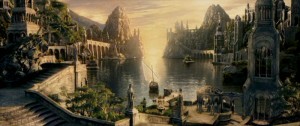 Q: What is the Gray Havens and what is its importance?
Q: What is the Gray Havens and what is its importance?
A: The Grey Havens was the coastal town and harbor founded by Cirdan at the beginning of the Second Age of Middle-earth. Cirdan held one of the Three Elven rings, Narya the Ring of Fire, which he gave to Gandalf upon his arrival in Middle-earth around the year 1000 of the Third Age. It was a stronghold for the Elves throughout the Second and Third Ages, and even into the Fourth Age. It was symbolically as well as physically the connecting point between the Valar in Valinor and the peoples of Middle-earth. By sailing from the Grey Havens, the Elves could find the straight road to Valinor after Valinor had been removed from the circles of the world, and the seas had been bent.
– Turgon
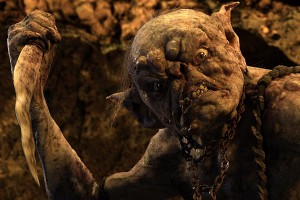 Q: I have a question for which I personally have 2 theories, but was wondering what “the experts” have to say. In re-reading the Prologue to Fellowship, I noticed that Tolkien refers to the party in the Hobbit getting wailaid by orcs, and Bilbo getting lost in orc caves, and Gollum eating orcs and so on. In The Hobbit, Tolkien calls them goblins. What’s the reason for this? My theories are these: 1) Blatant inconsistency (as much as I hate to even say it); 2) Tolkien uses the words interchangeably — goblins for a younger, less fantasy educated audience and orcs for a more mature fantasy audience. People who do not read fantasy would most likely not recognize orcs, whereas goblins and trolls would most likely be understood as “evil monsters.” Perhaps it’s neither. Please give me your insight with perhaps a more literate answer. I’d appreciate your time.
Q: I have a question for which I personally have 2 theories, but was wondering what “the experts” have to say. In re-reading the Prologue to Fellowship, I noticed that Tolkien refers to the party in the Hobbit getting wailaid by orcs, and Bilbo getting lost in orc caves, and Gollum eating orcs and so on. In The Hobbit, Tolkien calls them goblins. What’s the reason for this? My theories are these: 1) Blatant inconsistency (as much as I hate to even say it); 2) Tolkien uses the words interchangeably — goblins for a younger, less fantasy educated audience and orcs for a more mature fantasy audience. People who do not read fantasy would most likely not recognize orcs, whereas goblins and trolls would most likely be understood as “evil monsters.” Perhaps it’s neither. Please give me your insight with perhaps a more literate answer. I’d appreciate your time.
– Matt Creelman
A: Your answer number two pretty much captures my thoughts. In a letter dated 18 September 1954, Tolkien wrote to Hugh Brogan: “Your preference of goblins to orcs involves a large question, and a matter of taste, and perhaps historical pedantry on my part. Personally I prefer Orcs (since these creatures are not ‘goblins’, not even the goblins of George MacDonald, which they do to some extent resemble).” (Letters, no. 151). In an earlier letter to Naomi Mitchison, dated 25 April 1954, Tolkien had mentioned that his orcs “owe, I suppose, a good deal to the goblin tradition (goblin is used as a translation in The Hobbit, where orc only occurs once, I think), especially as it appears in George MacDonald, except for the soft feet which I never believed in.” (Letters, no. 144). Tolkien’s references to George MacDonald refer to MacDonald’s children’s books, The Princess and the Goblin (1872), and its sequel, The Princess and Curdie (1883).
– Turgon
Update!
Lee Waldman wrote in with a very pertinent comment: “It is important to note that Thorin Oakensheild’s sword was called Orcrist or goblin-cleaver by the elves of Gondolin who forged it. This suggests that Tolkien meant for the words to be interchangeable.”
– Turgon
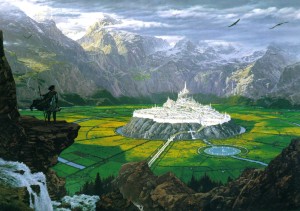 Q: Perhaps Turgon would be best suited to answer this, as I suspect this would fall into his realm of expertise. Regarding the Hidden City of Gondolin (for whose story I confess a certain interest in)… there are several mentions of the Seven Names for the city within the body of Tolkien’s writings. However, in my readings I have not found out what these seven names actually were. They are not spoken of in either The Silmarillion or Unfinished Tales, although I recently found two in the section on the Fall of Gondolin which I believe was in the Book of Lost Tales 2. One of these was “Gondobar”, though the other one escapes me at the moment. There is the Sindarin Gondolin, which of course means “hidden rock”, and the Quenya Ondolinde, meaning “rock of the music of water”. I do not believe that these names actually count among the seven, though. Perhaps someone with greater familiarity with the History of Middle Earth series, and/or other “sources” can find out what Tolkien originally had in mind for these names (doubtless in the early days of the conception of the Quenta Silmarillion, since it never made the final drafts). Or maybe it’s just one of those things that only Christopher knows for sure.
Q: Perhaps Turgon would be best suited to answer this, as I suspect this would fall into his realm of expertise. Regarding the Hidden City of Gondolin (for whose story I confess a certain interest in)… there are several mentions of the Seven Names for the city within the body of Tolkien’s writings. However, in my readings I have not found out what these seven names actually were. They are not spoken of in either The Silmarillion or Unfinished Tales, although I recently found two in the section on the Fall of Gondolin which I believe was in the Book of Lost Tales 2. One of these was “Gondobar”, though the other one escapes me at the moment. There is the Sindarin Gondolin, which of course means “hidden rock”, and the Quenya Ondolinde, meaning “rock of the music of water”. I do not believe that these names actually count among the seven, though. Perhaps someone with greater familiarity with the History of Middle Earth series, and/or other “sources” can find out what Tolkien originally had in mind for these names (doubtless in the early days of the conception of the Quenta Silmarillion, since it never made the final drafts). Or maybe it’s just one of those things that only Christopher knows for sure.
– Dan Fernandez
A: Asking me about my own domain, eh? Well, here’s the answer…
In “The Fall of Gondolin” in The Book of Lost Tales, Part Two, Tuor asks your very question (“What be those names?” ) to the chief of the Guard of the Gondothlim. The answer is given as follows: “‘Tis said and ’tis sung: ‘Gondobar am I called, and Gondothlimbar, City of Stone and City of the Dwellers in Stone; Gondolin the Stone of Song and Gwarestrin am I named, the Tower of Guard, Gar Thurion or the Secret Place, for I am hidden from the eyes of Melko; but they who love me most greatly call me Loth, for like a flower I am, even Lothengriol the flower that blooms on the plain.'” (p. 158) In The Lays of Beleriand, Christopher Tolkien gives some information about the poem “The Lay of the Fall of Gondolin”, in which one of the seven names of Gondolin differs slightly: “Loth-a-ladwen, the Lily of the Plain” is given by the Guard instead of Lothengriol. (see p. 149).
– Turgon


